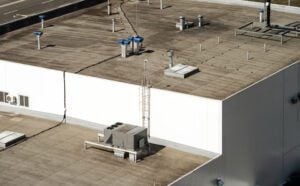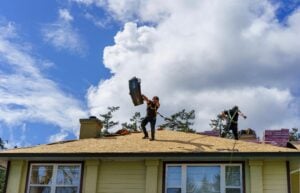Water damage is one of the most frustrating and common problems homeowners can face, especially when it affects laminate flooring. Whether it’s from a leaky appliance, burst pipe, or an unnoticed spill, water can wreak havoc on your laminate floors.
Unlike tile or vinyl, laminate isn’t built to handle excess moisture. However, water-damaged laminate flooring can often be repaired without needing to replace the entire floor if caught early.
If you’re wondering how to fix water-damaged laminate flooring, then you’re in the right place. This guide walks you through everything you need to know—from identifying signs of damage to step-by-step repair instructions and when to call Allphase Restoration.
Why Laminate Flooring Gets Damaged by Water
Laminate flooring may look like wood, but it’s made of layered synthetic materials that don’t stand up well to moisture.
Most laminate planks have a core layer made of medium-density fiberboard (MDF) or high-density fiberboard (HDF) and a backing layer for added stability—but the core layer is the problem.
The core is highly absorbent. Once water seeps into seams or underneath planks, the fiberboard begins to swell, crack, or break apart. And because the surface is usually water-resistant (not waterproof), damage often happens below the surface where you can’t see it right away.
Pro tip: The faster you stop the water and dry the area, the better your chances of saving your flooring.
How to Identify Water Damage in Laminate Flooring
Early signs of water damage in laminate flooring can be subtle. Here’s what to look for:
- Bubbling or blistering on the surface
- Edges lifting or curling at seams
- Planks separating or shifting out of place
- Soft spots when walking
- Discoloration or staining
- A musty or damp odor
It’s important to note that not all damage is immediate. Moisture trapped underneath can take days or even weeks to show visible signs. That’s why it’s essential to inspect what’s happening below the surface.
Moisture may have seeped into the underlayment or subfloor, especially if the flooring was installed in a basement, bathroom, or kitchen.

Repairing Water-Damaged Laminate Flooring
Before beginning repairs, prioritize safety. Shut off any active water sources and ensure the affected area is completely dry. If there’s visible mold, call Allphase Restoration to ensure proper remediation.
This section walks you through how to repair floating laminate floors in six steps.
Step 1 – Stop the Source of Water and Let the Area Dry
Start by identifying and fixing the source of the moisture. Common culprits include leaky appliances and plumbing failures.
Once the source is fixed, you can use things like fans, dehumidifiers, and open windows to promote airflow and dry the area.
Allow at least 24–48 hours of drying time before proceeding. Surface-level drying isn’t enough—you want the subfloor and underlayment to be fully dry as well.
Step 2 – Remove Damaged Planks
Carefully remove the trim or baseboards around the damaged section. These are usually nailed or caulked in and can be pried up with a flat bar.
Next, remove the laminate planks starting from the nearest wall and working toward the damaged section.
Step 3 – Check the Subfloor for Moisture or Mold
Once the planks are removed, examine the subfloor for any lingering moisture, softness, or signs of mold or mildew.
If the subfloor is wet, use fans and dehumidifiers to thoroughly dry it. If you find mold, scrub the area with a mold-removal solution and consider sealing it with a mold-resistant primer once it is dry.
If the subfloor is severely damaged or too soft, it is recommended to call a professional.
Step 4 – Replace the Underlayment if Needed
Underlayment is a thin layer of foam or felt placed between your laminate planks and the subfloor. If it’s soggy, deteriorating, or moldy, replace it entirely. Skipping this step can lead to future damage and make your new flooring vulnerable to moisture.
Roll out new underlayment and trim it to fit the repair area. Make sure it lies flat with no wrinkles or overlaps.
Step 5 – Install New Matching Laminate Planks
Using leftover planks from the original installation is ideal. If you don’t have spares, take a sample to your local flooring store or order replacements online.
Even slight color or texture differences can stand out, so aim for the best match possible.
Depending on your flooring type, use the click-lock mechanism or the glue-down method. Start from the wall and reassemble the planks toward the repair area, ensuring they are snug.
Step 6 – Reattach the Trim and Clean the Area
Once the planks are in place, reinstall your trim or baseboards. Caulk gaps and touch up any paint as needed.
Finally, clean the floor thoroughly with a non-abrasive laminate cleaner. Avoid using excessive water or steam, which can damage the new planks.
Experiencing larger structural issues after water exposure? Our flooded basement cleanup experts can help assess and restore underlying damage.
Can You Repair Laminate Flooring Without Replacing Planks?
In some cases, yes—but it depends on the extent of the damage. Slight buckling or lifting can sometimes be flattened with weight after the material has dried.
Minor chips or scratches can also be filled using laminate repair kits. However, these fixes are cosmetic.
If planks are warped, swollen, or moldy, replacement is the best solution.
When You Should Replace the Entire Floor
If the damage is widespread, replacing the entire floor may be more cost-effective than patching small areas. Full replacement is often necessary if water has affected large sections, mold is growing, or if the subfloor is damaged beyond repair.
Before committing to repairs, consider long-term performance and resale value. And don’t forget—home insurance may help cover the cost if a covered incident like a burst pipe or roof leak caused the damage.
For expert help evaluating your options, contact Allphase Restoration for a comprehensive flooring inspection and a customized quote.
How to Prevent Water Damage to Laminate Flooring
Preventing water damage is the best step forward, especially in areas prone to moisture, such as kitchens, basements, and bathrooms. Make sure to:
- Clean spills immediately
- Use water-resistant underlayment
- Keep humidity below 60%
- Use mats near entryways and sinks
- Install a moisture barrier in basements or over concrete
Is Waterproof Laminate Flooring a Better Option?
Traditional laminate is vulnerable to moisture, but newer technology has made significant strides.
Water-resistant laminate (such as AquaGuard or Mohawk RevWood) offers better water protection, while waterproof laminate (like AquaSeal or Pergo WetProtect) features sealed joints and a waterproof core.
If you’re installing laminate in bathrooms, kitchens, or below-grade spaces, waterproof options are a wise investment.
Looking to upgrade after water damage? Allphase Restoration can help you choose and install long-lasting waterproof flooring as part of our restoration services.
When to Call a Professional for Laminate Flooring Water Damage
DIY fixes can work for minor damage, but there are times when calling a professional is the safest choice:
- You suspect mold under the floor
- The subfloor feels soft or warped
- Damage affects a large portion of the room
- You don’t have matching planks
- You want a fast, hassle-free solution
A restoration expert can help you identify the full extent of the damage (including what’s not visible) and recommend whether repair or replacement makes more sense.
Professional tools, such as moisture meters, thermal imaging devices, and commercial-grade drying equipment, go far beyond what a homeowner typically has on hand.
Why Choose Allphase for Laminate Flooring Water Damage Repair
At Allphase Restoration, we specialize in water damage repair—from surface-level laminate fixes to deep subfloor restoration and mold removal.
Here’s what sets us apart from the rest:
- Decades of hands-on experience in residential and commercial restoration
- Fast, expert response times when every minute counts
- Skilled, certified technicians who do the job right the first time
- Top-tier materials and tools to ensure durable, long-lasting results
- Clear communication and a satisfaction guarantee
We’re trusted across Ohio for our quality, transparency, and commitment to excellence. Whether it’s a small leak or a full-blown flood, Allphase is the name to call for fire damage restoration, storm damage restoration, and everything in between.
Contact Allphase for Cleanup & Restoration Services Today
Dealing with water-damaged laminate flooring? We’re here to help.
Call Allphase Restoration today or request a quote through our easy online form. Our team proudly provides on-site inspections, damage assessments, and recommendations for laminate flooring repair and replacement. We also handle full-service cleanup and mold remediation.
Don’t wait until the problem spreads—contact Allphase Restoration now and restore your floors with confidence.
FAQs – Laminate Flooring Water Damage Repair
1) Can I just dry the laminate with a heater or fan?
You can dry the surface, but internal damage may still exist. If planks are swollen or warped, they’ll likely need to be replaced.
2) Will water under the floor evaporate on its own?
It’s unlikely. Trapped moisture under laminate can linger, leading to mold or subfloor damage. Professional drying is often necessary.
3) Do I need to remove all planks if only part of the floor is damaged?
Not always. If you can isolate the affected area and have matching planks, you may only need to remove a section.
4) Will laminate flooring dry out if left alone after a small leak?
Laminate flooring may appear dry on the surface, but remains wet underneath. Always inspect the underlayment and subfloor to be sure.
5) Do you need to replace the underlayment if it gets wet?
Yes—wet underlayment can harbor mold and lose its cushioning. It should be fully replaced during repairs.




